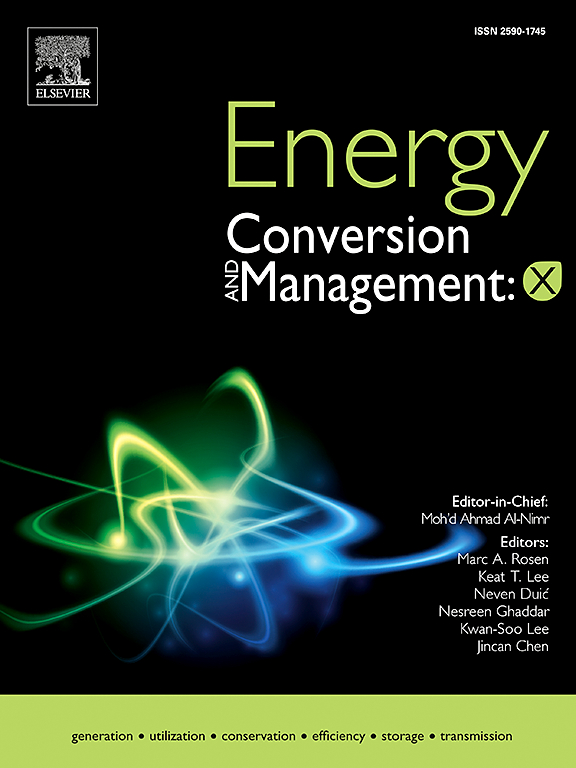Integrative approach to hydrothermal gasification of food waste for hydrogen production: experimental validation, techno-economic assessment, and mathematical modeling
IF 7.1
Q1 ENERGY & FUELS
引用次数: 0
Abstract
This study conducts a techno-economic and environmental analysis to assess the viability and benefits of H2 production from food waste via hydrothermal gasification (HTG). Experimental results were used to examine the effects of critical parameters, including temperature, reaction time, and catalyst use, on H2 yield. Response surface methodology (RSM) was employed to explore the relationships among operational factors and to develop a mathematical model that forecasts various experimental outcomes. Fourier Transform Infrared Spectroscopy (FTIR) was utilized to analyse the chemical properties of bio-oil. The most favourable parameters for this process are 350 °C and 18 MPa, resulting in a maximum yield of 796 mL after 90 min. Sodium hydroxide (NaOH) significantly enhances H2 production to approximately 800 cc, surpassing the performance of other catalysts. FTIR analysis reveals the chemical complexity of bio-oil, which presents promising prospects for sustainable fuel. Replacing 1.9 Mt of coal, 1.3 Mt of diesel, and 1.19 Mt of natural gas with H2 can result in a cost savings of M$ 228 by 2023. This comprehensive study offers a comprehensive perspective on implementing H2 energy through HTG technology.
食物垃圾水热气化制氢的综合方法:实验验证、技术经济评估和数学建模
本研究进行了技术经济和环境分析,以评估通过水热气化(HTG)从食物垃圾中制氢的可行性和效益。实验结果考察了温度、反应时间、催化剂用量等关键参数对H2产率的影响。采用响应面法(Response surface methodology, RSM)探讨各操作因素之间的关系,并建立数学模型来预测各种实验结果。利用傅里叶变换红外光谱(FTIR)对生物油的化学性质进行了分析。该工艺的最佳工艺参数为350°C和18 MPa, 90 min后产率最高为796 mL。氢氧化钠(NaOH)显著提高H2产率至约800 cc,超过其他催化剂的性能。红外光谱分析揭示了生物油的化学复杂性,为生物油的可持续发展提供了广阔的前景。用氢气替代190万吨煤、130万吨柴油和119万吨天然气,到2023年可节省228马币的成本。这项综合研究为通过HTG技术实现H2能源提供了全面的视角。
本文章由计算机程序翻译,如有差异,请以英文原文为准。
求助全文
约1分钟内获得全文
求助全文
来源期刊

Energy Conversion and Management-X
Multiple-
CiteScore
8.80
自引率
3.20%
发文量
180
审稿时长
58 days
期刊介绍:
Energy Conversion and Management: X is the open access extension of the reputable journal Energy Conversion and Management, serving as a platform for interdisciplinary research on a wide array of critical energy subjects. The journal is dedicated to publishing original contributions and in-depth technical review articles that present groundbreaking research on topics spanning energy generation, utilization, conversion, storage, transmission, conservation, management, and sustainability.
The scope of Energy Conversion and Management: X encompasses various forms of energy, including mechanical, thermal, nuclear, chemical, electromagnetic, magnetic, and electric energy. It addresses all known energy resources, highlighting both conventional sources like fossil fuels and nuclear power, as well as renewable resources such as solar, biomass, hydro, wind, geothermal, and ocean energy.
 求助内容:
求助内容: 应助结果提醒方式:
应助结果提醒方式:


